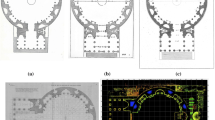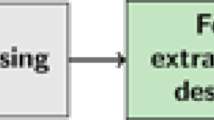Abstract
The Morgan Library & Museum, New York, owns one of the largest and most prestigious collections of block books in the world, most of which are attributed to the Netherlands and Germany and dated to ca. 1460–1490. Block books are rare examples of early multi-page works produced entirely from hand-colored woodcuts, with both imagery and text carved in relief from a single block. Although created for only a few decades in the late 15th century, block books are relevant in that they represent an alternative production method to the coeval invention of typographic printing, which, upon introduction, quickly dominated the book market. As little is known about the composition of early printing inks and, more broadly, of the materials constituting these unusual objects, an extensive campaign of scientific analysis was undertaken using various non-invasive and micro-invasive techniques. Examination of the paper and watermarks provided information regarding provenance and dating of the books. Their polychrome imagery was found to have been created through a widespread use of both mineral pigments and natural dyes, often present in complex mixtures and applied in various ways. Similarly, the printing inks typically consist of combinations of carbon-based and iron gall inks, sometimes mixed with red mineral pigments likely to adjust their hue. In a few cases, modern pigments were also identified on inserted replacement pages, pointing to later interventions. This research has substantially enriched the current knowledge of the materials and techniques employed in block books and securely links them to single-leaf woodcuts of the 15th century, placing them in a medieval illumination tradition.










Similar content being viewed by others
References
N.F. Palmer, B.D. Honey, in A catalogue of books printed, in the fifteenth century now in the Bodleian Library. ed. by A. Coates, K. Jensen, C. Dondi, B. Wagner, H. Dixon (Oxford University Press, New York, 2005), pp. 7–21
N.F. Palmer, Renaiss. Stud. 9, 2 (1995)
J.F. Hamburger, Mediu. Aev. 83, 2 (2014)
S. Mertens, E. Purpus, C. Schneider, Blockbücher Des Mittelalters: Bilderfolgen Als Lektüre (Gutenberg-Museum, Mainz, 1991).
W.L. Schreiber, Manuel de l'amateur de la gravure sur bois et sur métal au XVe siècle: Contenant un catalogue des livres xylographiques et xylo-chirographiques: indiquant les différences de toutes les éditions existantes; avec des notes critiques, bibliographiques et iconographiques, Vol. 4 (Cohn, 1902)
N.F. Palmer, Stud. Hist. Art. 75 (2009)
P. Needham, Stud. Hist. Art. 75 (2009)
D. Oltrogge, in Printing colour 1400–1700: history, techniques, functions and receptions, ed. by A. Stijnman, E. Savage (Brill, 2015)
P. Ricciardi, K.B. Beers, in Colour: the art and science of illuminated manuscripts. ed. by S. Panayotova, D. Jackson, P. Ricciardi (Harvey Miller Publishers, London, 2016), p. 27
D.V. Thompson, Cennini, C. The craftsman’s handbook (Courier Corporation, Dover, 1954), pp. 115–117
A. Stijnman, in Bibliothek und Wissenschaft, vol. 46, ed. by C. Fabian, M. Knoche, M. Linder, E. Mittler, W. Schmitz, H. Vogeler (Harrassowitz Verlag, Wiesbaden, 2013), p. 59
D. Cardon, Natural dyes. Sources, tradition, technology and science (Archetype Publications, London, 2007)
M.P. Merrifield, Medieval and Renaissance Treatises on the Arts of Painting (Courier Corporation, Dover, 1999).
D.V. Thompson, The Materials and Techniques of Medieval Painting (Courier Corporation, Dover, 1956).
R.N. Schwab, T.A. Cahill, B.H. Kusko, D.L. Wick, Pap. Bibliogr. Soc. Am. 77, 3 (1983)
R.N. Schwab, T.A. Cahill, B.H. Kusko, R.A. Eldred, D.L. Wick, Pap. Bibliogr. Soc. Am. 81, 4 (1987)
P. Zahn, Printer’s inks and papers in early incunabula under synchrotron light (SYXRF). Gazette du livre medieval 21, 1 (1992)
H. Mommsen, T. Beier, H. Dittmann, D. Heimermann, A. Hein, A. Rosenberg, M. Boghardt, E.M. Hanebutt-Benz, H. Halbey, Archaeometry 38, 2 (1996)
T. Stanley, J. Am. Inst. Conserv. 57, 4 (2018)
S. Fletcher, L. Glinsman, D. Oltrogge, Stud. Hist. Art. 75 (2009)
M. Aceto, A. Agostino, G. Fenoglio, A. Idone, M. Gulmini, M. Picollo, P. Ricciardi, J.K. Delaney, Anal. Methods 6, 5 (2014)
F. Pozzi, E. Basso, A. Rizzo, A. Cesaratto, T.J. Tague Jr., J. Raman Spectrosc. 50, 6 (2019)
M. Leona, P. Natl, Acad. Sci. USA 106, 35 (2009)
M. Leona, J. Stenger, E. Ferloni, J. Raman Spectrosc. 37, 10 (2006)
F. Pozzi, J.R. Lombardi, S. Bruni, M. Leona, Anal. Chem. 84, 8 (2012)
C. Mouri, R. Laursen, J. Chromatogr. A 1218, 41 (2011)
A. Stevenson, The British Museum Quarterly 31, 3/4 (1967)
S. Bucklow, in Colour: the art and science of illuminated manuscripts. ed. by S. Panayotova, D. Jackson, P. Ricciardi (Harvey Miller Publishers, London, 2016), p. 62
E. Phipps, Cochineal red: the history of a color. Metrop. Mus. Art Bull. 67 (2010)
N. Eastaugh, V. Walsh, T. Chaplin, R. Siddall, Pigment Compendium: A Dictionary of Historical Pigments (Elsevier Butterworth-Heinemann, Oxford and Burlington, 2007).
M. Spring, R. Grout, National Gallery Technical Bulletin 23 (2002)
J. Yu, W.S. Warren, M.C. Fischer, Sci. Adv. 5, 6 (2019)
F. Delamare, Blue Pigments: 5000 Years of Art and Industry (Archetype Publications, London, 2013).
B.H. Berrie, Early Sci. Med. 20, 4–6 (2015)
S. Bruni, V. Guglielmi, F. Pozzi, A.M. Mercuri, J. Raman Spectrosc. 42, 3 (2011)
R.J. Gettens, E.W. Fitzhugh, Stud. Conserv. 19, 1 (1974)
C. Weeks, Stud. Conserv. 43, 2 (1998)
A. Coccato, L. Moens, P. Vandenabeele, Herit. Sci. 5, 1 (2017)
M. Oujja, M. Sanz, E. Rebollar, J.F. Marco, C. Domingo, P. Pouli, S. Kogou, C. Fotakis, M. Castillejo, Spectrochim. Acta A 102 (2013)
M.J. Melo, P. Nabais, M. Guimarães, R. Araújo, R. Castro, M.C. Oliveira, I. Whitworth, Philos. Trans. Royal Soc. A 374, 2082 (2016)
J. Havermans, H.A. Aziz, H. Scholten, Restaurator 24, 2 (2003)
O. Hahn, W. Malzer, B. Kanngießer, B. Beckhoff, X-Ray Spectrom. 33, 4 (2004)
O. Hahn, B. Kanngießer, W. Malzer, Stud. Conserv. 50, 1 (2005)
Acknowledgements
The authors would like to acknowledge Nobuko Shibayama, Research Scientist at The Met, for her precious guidance with HPLC-PDA data interpretation. They are also grateful to Yvonne Hearn, former Sherman Fairchild Fellow in Conservation at The Morgan Library, for assisting with IRRFC imaging; to Elyse Driscoll, Assistant Paper Conservator at the Brooklyn Museum, for preliminary XRF and IRRFC work; to Timothy Barrett, recently retired Director of the Center for the Book, University of Iowa, for sharing his observations and expertise in hand papermaking; and to John McQuillen, Associate Curator of Printed Books at The Morgan Library, for his help interpreting the meaning of the data collected. All images of block books in this article are published with permission from The Morgan Library & Museum, New York. Photography by Janny Chiu, Graham S. Haber, or Reba F. Snyder.
Funding
This research was made possible by the Network Initiative for Conservation Science (NICS), a Metropolitan Museum of Art program. Support for NICS was provided by a grant (31500630) from The Andrew W. Mellon Foundation.
Author information
Authors and Affiliations
Contributions
FP and EB carried out in situ, non-invasive XRF, Raman, and FORS analysis and data interpretation. FP removed samples, performed Raman, SERS, and HPLC–PDA micro-invasive analysis and data interpretation, and wrote the manuscript draft with inputs from the other authors. EB conducted SEM/EDS micro-invasive analysis and data interpretation. RS provided art historical context, performed visual examination and beta radiography, and supported the scientific work. All authors reviewed and approved the final manuscript.
Corresponding author
Ethics declarations
Conflict of interest
The authors declare that they have no conflict of interest.
Availability of data and material
All data generated during this study are either included in this published article or available from the corresponding author upon reasonable request.
Supplementary Information
Below is the link to the electronic supplementary material.
Supplementary Figure 1
Two blank pages, namely leaves 10v-11r, of PML21990. Most pages in block books are printed on only one side and the verso of each sheet appears strongly embossed by the woodblock, making it unusable for printing
Supplementary file1 (TIF 48111 kb)
Supplementary Figure 2
Hand-made annotations on unprinted versos of leaf 16 of PML6 (left) and leaves 20v-21r of PML3193 (right)
Supplementary file2 (TIF 5449 kb)
Supplementary Figure 3
Leaves 4v-5r of PML1051, displaying significant variations in paper color and density
Supplementary file3 (TIF 15680 kb)
Supplementary Figure 4
Two details from leaf 48 of PML5 and photomicrographs of samples removed from the corresponding locations, showing two different shades of purple made by finely mixing (top) or superimposing (bottom) azurite and carmine lake.
Supplementary file4 (TIF 2832 kb)
Supplementary Figure 5
(a) XRF spectrum of a brown area from leaf 1 of PML1051, exhibiting intense Fe and Mn peaks that are indicative of iron-containing earths and umber pigments. (b) XRF spectrum of a blue area from leaf 48 of PML5, showing Cu, Si, K, Co, As, and Bi peaks, suggesting that azurite may be present along with a smalt pigment produced in Saxony or other regions of Central Europe from the first half of the sixteenth century
Supplementary file5 (TIF 1329 kb)
Supplementary Figure 6
Two details of different green colors made by combining mineral pigments (PML5, left) or applying them on top of an organic yellow base coat (PML7, right)
Supplementary file6 (TIF 2370 kb)
Supplementary Figure 7
IRRFC images of a selection of block books among those analyzed, revealing that while a more intense response was associated with the brown inks (top), some of the black and gray ones also showed as red using this type of imaging technique (bottom). From top left to bottom right: leaf 12b of PML3, leaf 22 of PML20680, leaf 37 of PML6, and leaf 35 of PML1051
Supplementary file7 (TIF 14775 kb)
Rights and permissions
About this article
Cite this article
Pozzi, F., Basso, E. & Snyder, R. Color, collation, and curious creatures: a technical study of 15th-century block books at The Morgan Library & Museum. Eur. Phys. J. Plus 136, 414 (2021). https://doi.org/10.1140/epjp/s13360-021-01335-w
Received:
Accepted:
Published:
DOI: https://doi.org/10.1140/epjp/s13360-021-01335-w




